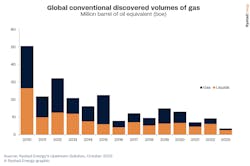Rystad Energy: New natural gas production needed to meet demand
Global gas demand is projected to rise in the next decade, leading to a 12.5% production surge anticipated between 2023 and 2030. However, according to Rystad Energy's forecasts, even under scenarios of temperature increases of 1.9°C and 2.5°C, with significant expansion in renewable energy sources, current existing gas fields will fall short of meeting the global demand, requiring rapid growth in unconventional gas supply.
Regions abundant in natural gas resources, such as the Middle East, particularly in basins like Rub al Khali, will play a crucial role in bridging this gap. They will provide about 20 million tonnes/year (tpy) of LNG by 2040, Rystad Energy estimates.
Production of unconventional gas, such as shale, has experienced rapid growth due to technological advancements and reduced lead times. This growth has driven the share of unconventional gas supply in global gas production at a much quicker pace than previously required, with anticipated escalation to 35% in 2023 from 12% in 2022 and 4% in 2000.
The influx of affordable gas from unconventional sources and ongoing supply from exporting countries like Russia has tempered exploration efforts for conventional gas. Nearly 70% of discovered conventional volumes have yet to receive sanction for development, showcasing the hurdles and reluctance to develop some of the finds, Rystad Energy said.
Historically, Russia and the Middle East have dominated conventional gas production. This is not slowing anytime soon, as Middle Eastern countries are ramping up gas volumes as part of energy transition strategies.
“With reduced emissions and regional energy security goals aligned, gas is poised to play a pivotal role in the global energy transition. The Middle East is a key driver of this shift, slowly moving into developing and increasing gas volumes as part of their new energy transition strategies,” said Aatisha Mahajan, vice-president of exploration at Rystad Energy.
Embrace unconventional
The Gulf Cooperation Council (GCC) region has traditionally been a dominant force in oil and gas production. Nevertheless, a decline in significant conventional discoveries in recent years has prompted countries in the region to shift focus to exploring and developing more unconventional resources.
Saudi Arabia aims to eliminate oil from its power production and with a goal of an 50-50 electricity generation split between renewables and natural gas by 2030. Transition to a more diversified energy landscape is driving an increased demand for gas within the country, with projections indicating it will reach 125 billion cu m (bcm) annually by the end of the decade.
To match burgeoning demand, Saudi Arabia will require new production from non-associated gas fields as well as unconventional gas plays, such as Jafurah field. From the field, the most extensive liquids-rich shale gas play in the Middle East, operator Saudi Aramco plans to hit peak shale gas production of 2 bcfd by 2030 and expects a lifetime investment exceeding $100 billion.
Rystad estimates this target production will be met in the second half of the 2030s. By then, the project could account for nearly 15% of Saudi Arabia’s total gas production, providing a significant increase to the nation’s overall gas supply.
Call for capital
Global gas demand will rise toward the middle of the 2030s. However, currently producing and underdeveloped gas fields are expected to reach peak production in the next couple of years before starting to decline. Even considering fields yet to be sanctioned and currently in discovery phase, peak production is still far from realization under ideal scenarios, Rystad said.
“Our analysis of global warming scenarios suggests more gas exploration and production is required to meet 1.9°C or 2.5°C of warming. In every scenario except the 1.6°C, additional gas resources are needed to meet demand. Therefore, gas exploration and additional capital investment within prominent gas basins or gas-rich countries are necessary.”
Unconventional gas will continue to play a prominent role in the world’s supply mix, estimated to increase to about a third by 2030. The expected increase in unconventional production is primarily due to a decline in exploration success over the past decade and the lack of developed conventional gas projects, leading to a drop in the overall conventional gas supply.
Only 32% of conventional gas volumes discovered since 2010 are producing, with more than 50% yet to be approved for development. As a result, countries that rely on conventional sources of gas will have to turn to unconventional volumes to meet net-zero targets and satisfy global demand if they do not increase investment in production.

